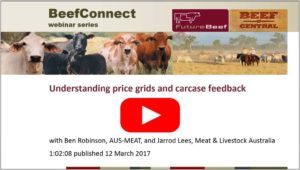Price grids show where the money is
 Most meat processors and feedlot operators purchase cattle on a price grid. The grid indicates by price, which are the most desirable animals and shows discounts for animals not meeting the ideal specifications. While prices may vary from week to week, specifications for the ideal animal for a particular market do not change very often.
Most meat processors and feedlot operators purchase cattle on a price grid. The grid indicates by price, which are the most desirable animals and shows discounts for animals not meeting the ideal specifications. While prices may vary from week to week, specifications for the ideal animal for a particular market do not change very often.
Some grids offer higher premiums but may also have larger discounts for animals falling outside the ideal specification. Others may be wider and easier to fit more cattle into resulting in a better average price.
To assess which price grid is going to give you the highest return and to match livestock to specifications it is necessary to accurately assess your cattle for live weight, expected dressed weight, dentition and P8 (rump) fat depth. For more information see Live assessing to meet market specifications.
Producers can upgrade their skills in assessing live animals by estimating carcase traits on animals before they are sold and comparing this with feedback or by employing experienced marketers.
A grid is a good example of value-based trading where products, in this case, carcases are priced according to objective measurements of what is valued by the customer. The more accurately a product can be identified, measured and priced according to its value for a particular market, the higher the degree of value-based payment. Whether breeding or trading cattle, good records and more accurate value-based trading will reveal which cattle are most valuable and where they have come from. Perhaps one of the greatest difficulties of value-based trading and interpreting feedback is tracing individual animal records on the property and obtaining feedback from buyers that can be matched to the specific animal.
The following example grid shows the premium carcase in the top row. It has between 7–22mm P8 fat, 0–4 teeth and over 300kg dressed carcase weight. Exceeding 22mm fat reduces the carcase value by 5¢ whilst having 6 teeth reduces price by 2¢. Five cents across a 300kg carcase equates to $15 while 2¢ equates to $6. Contact processors to obtain their price grids.
Example Jap Ox specifications |
||||
|---|---|---|---|---|
| Cents per kg dressed weight | ||||
| Fat (mm) | Teeth | Butt shape | Carcase 300–420kg | Carcase 280–299kg |
| 7–22 | 0–4 | A–C | +12¢ | – |
| 23–32 | 0–4 | A–C | +7¢ | – |
| 7–22 | 0–6 | A–C | +10¢ | +5¢ |
| 23–32 | 0–6 | A–C | +5¢ | Base carcase price |
| 7–22 | 7–8 | A–C | +5¢ | – |
| 23–32 | 7–8 | A–C | Base carcase price | – |
| Heifers as steers less 5¢ per kg | ||||
It is worth studying grids to identify where price changes occur, for example US ox or cow carcases below 200kg and 3mm P8 fat can result in a huge price drop compared with meeting these specifications.
Marbling
Marbling becomes important with specialist markets to Japan that require at least 200 days lot feeding. The higher the marble score the higher the carcase value, assuming other necessary specifications such as meat and fat colour and texture are also met. Due to high inputs to achieve these markets, failure to meet specifications is very costly.
Market specifications indicate which animals or carcase characteristics are important to your customer. In the longer-term, nutrition, management and genetics can be used to modify production to target particular specifications whilst tactically cattle can be drafted to meet specifications.
It is important to calculate the cost of meeting a certain market versus the returns. This will show if it is worth spending extra dollars to lift carcase weights and or P8 fat levels into a ‘near by’ higher price bracket.
Roger Sneath, Department of Agriculture and Fisheries.